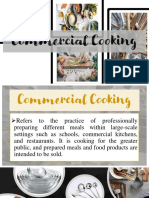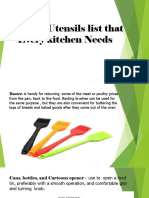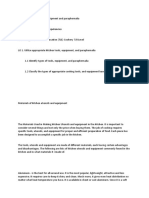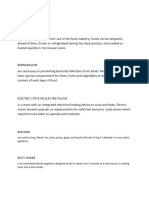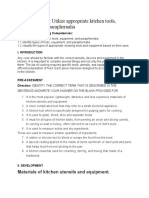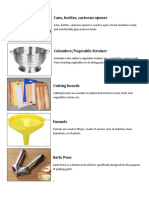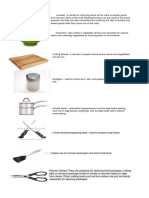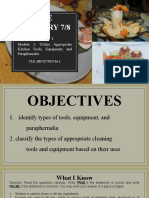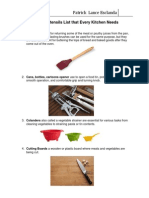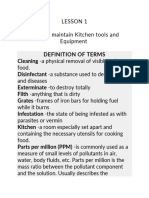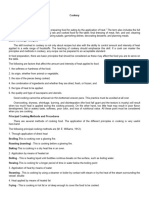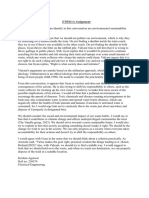Project in TLE
Project in TLE
Uploaded by
Daisy Paesaje MoncanoCopyright:
Available Formats
Project in TLE
Project in TLE
Uploaded by
Daisy Paesaje MoncanoCopyright
Available Formats
Share this document
Did you find this document useful?
Is this content inappropriate?
Copyright:
Available Formats
Project in TLE
Project in TLE
Uploaded by
Daisy Paesaje MoncanoCopyright:
Available Formats
Project In
T.L.E
Name: Daisy Rhose Moncano Grade: 8-1 January 27, 2014 Materials of kitchen utensils and equipment commonly found in the kitchen.
Any cook should be familiar with the correct utensils, devices and equipment in the kitchen. It is important to consider several things and not only the price when buying them. The job of cooking requires specific tools, utensils, and equipment for proper and efficient preparation of food. Each piece has been designed to accomplish a specific job in the kitchen. The tools, utensils and equipment are made of different materials, each having certain advantages and disadvantages. The following lists are materials of kitchen utensils and equipment commonly found in the kitchen.
Maam Quilala
A baster is handy for returning some of the meat or poultry juices from the pan, back to the food. Basting brushes can be used for the same purpose, but they are also convenient for buttering the tops of breads and baked goods after they come out of the oven. Cans, bottles, cartoons opener use to open a food tin, preferably with a smooth operation, and comfortable grip and turning knob.
Colanders also called a vegetable strainer are essential for various tasks from cleaning vegetables to strainingpasta or tin contents.
Cutting Boards a wooden or plastic board where meats and vegetables can be cut.
Dredgers used to shake flour, salt, and pepper on meat, poultry, and fish.
Double boiler used when temperatures must be kept below boiling, such as for egg sauces, puddings, and to keep foods warm without overcooking.
Emery boards/sharpening steel used to sharpen long knives.
Flipper use for turning hamburgers and other food items
Funnels used to fill jars, made of various sizes of stainless steel, aluminum, or of plastic
Garlic Press is a kitchen tool which is specifically designed for the purpose of pulping garlic for cooking.
Graters used to grate, shred, slice and separate foods such as carrots, cabbage and cheese.
Handy Poultry & Roasting Tools make it easier to lift a hot roasted turkey from the roaster to the serving platter, without it falling apart.
knives are a must for all types of kitchen tasks, from peeling an onion and slicing carrots, to carving a roast or turkey Kitchen Shears They are practical for opening food packages, cutting tape or string to package foods or simply to remove labels or tags from items. Other cutting tools such as box cutters are just as handy, especially for opening packages. Measuring Cups, Spoons Measuring tools are among the most important items found in any kitchen, since consistently good cooking depends upon accurate measurements. Measuring tools should be standardized. Measuring cups and spoons are also in the home kitchen. Pasta Spoon or Server is use to transfer a little or much cooked pasta to a waiting plate, without mess. Pasta spoons are best used with spaghetti-style or other long pasta noodles; you can use a large slotted serving spoon for short pastas. Potato Masher used for mashing cooked potatoes, turnips, carrots or other soft cooked vegetables.
Rotary eggbeater used for beating small amount of eggs or batter. The beaters should be made up of stainless steel, and gear driven for ease in rotating
Scraper- a rubber or silicone tools to blend or scrape the food from the bowl; metal, silicone or plastic egg turners or flippers Seafood Serving Tools make the task of cleaning seafood and removing the shell much easier. For cooking seafood, utensils will vary depending on what you are cooking.
Serving spoons- a utensil consisting of a small, shallow bowl on a handle, used in preparing, serving, or eating food.
Soup Ladle is used for serving soup or stews, but can also be used for gravy, dessert sauces or other foods. A soup ladle also works well to remove or skim off fat from soups and stews. Spoons solid, slotted, or perforated. Made of stainless steel or plastic, the solid ones are used to spoon liquids over foods and to lift foods, including the liquid out of the pot Temperature Scales - used to measure heat intensity. Different thermometers are used for different purposes in food preparation for meat, candy or deep-fat frying. Other small thermometers are hanged or stand in ovens or refrigerators to check the accuracy of the equipments thermostat.
Two-tine fork used to hold meats while slicing, and to turn solid pieces of meat while browning or cooking Made of stainless steel and with heatproof handle.
Vegetable peeler. used to scrape vegetables, such as carrots and potatoes and to peel fruits. The best ones are made of stainless steel with sharp double blade that swivels.
Whisks for Blending, Mixing used for whipping eggs or batter, and for blending gravies, sauces, and soups. The beaters are made of looped steel piano wires which are twisted together to form the handle
Equipment More complicated tools are called equipment. They may refer to a small electrical appliance, such as a mixer, or a large, expensive, power-operated appliance such a range or a refrigerator. Equipment like range, ovens, refrigerators (conventional, convection and microwave) are mandatory pieces in the kitchen or in any food establishment.
Refrigerators/Freezers are necessary in preventing bacterial infections from foods. Most refrigerators have special compartment for meat, fruits and vegetables to keep the moisture content of each type of food. Butter compartment holds butter separately to prevent food odors from spoiling its flavor. Basically, refrigerator or freezer is an insulated box, equipped with refrigeration unit and a control to maintain the proper inside temperature for food storage. Microwave Ovens have greatly increased their use in the food industry. Foods can be prepared ahead of time, frozen or refrigerated during the slack periods, and cooked or heated quickly in microwave ovens
Auxiliary equipment like griddles, tilting skillets, broilers/grills, steamers, coffee makers, deep-fat fryers, wok, crockery, cutting equipment (meat slicer, food choppers, grinders) mixers and bowls, pots and pans are utilized most commonly in big food establishments, some with specialized uses and some are optional.
Blenders are used to chop, blend, mix, whip, puree, grate, and liquefy all kinds of food. A blender is a very useful appliance. They vary in the amount of power (voltage/wattage). Others vary and do not do the same jobs.
You might also like
- Boast - Issue 15 - December 2023Document80 pagesBoast - Issue 15 - December 2023clubeautomovelviseuNo ratings yet
- Barringer E3 TB 04 PDFDocument17 pagesBarringer E3 TB 04 PDFXiAo LengNo ratings yet
- Kitchen Materials, Tools and Equipment (Use and Maintenance)Document77 pagesKitchen Materials, Tools and Equipment (Use and Maintenance)Jesica AndayaNo ratings yet
- I, You, He, She, It, We, They: GreetingDocument20 pagesI, You, He, She, It, We, They: GreetingkrystenNo ratings yet
- 02.telangana Standard Data Yr 2020-21 19.08.2020Document451 pages02.telangana Standard Data Yr 2020-21 19.08.2020surya100% (1)
- Cooking Utensils List That Every Kitchen NeedsDocument50 pagesCooking Utensils List That Every Kitchen NeedsBaby MacNo ratings yet
- Q2 MODULE1 G7-OR-8 COOKERY BautistaNHSDocument10 pagesQ2 MODULE1 G7-OR-8 COOKERY BautistaNHSDirty Sam LicudoNo ratings yet
- Tle Module 1Document8 pagesTle Module 1Miles BarrozoNo ratings yet
- Kitchen ToolsDocument35 pagesKitchen ToolsMe TooNo ratings yet
- Utilize Kitchen Tools and Equipment and ParaphernaliaDocument12 pagesUtilize Kitchen Tools and Equipment and ParaphernaliaAimee SiocoNo ratings yet
- Quarter 3 Lesson 1 - Grade 7Document57 pagesQuarter 3 Lesson 1 - Grade 7Shara Franchesca MonterubioNo ratings yet
- Q1 MODULE1 G9 Cookery BautistaNHSDocument10 pagesQ1 MODULE1 G9 Cookery BautistaNHSElaeca AbenNo ratings yet
- Commercial CookingDocument33 pagesCommercial CookingShiela TubigNo ratings yet
- EquipmentDocument8 pagesEquipmentkororo mapaladNo ratings yet
- Topic 5-Cooking Tools in Aid of NutritionDocument14 pagesTopic 5-Cooking Tools in Aid of NutritionMARY GRACE CABILINo ratings yet
- Bef 75 A 6 C 1 FBBDocument47 pagesBef 75 A 6 C 1 FBBambasezekielsamirNo ratings yet
- Module in TLE 8Document9 pagesModule in TLE 8Israel Marquez75% (4)
- Module in TLE 9 q4Document9 pagesModule in TLE 9 q4Israel MarquezNo ratings yet
- TLE Lesson 1 AND 2Document82 pagesTLE Lesson 1 AND 2Laila ArcillasNo ratings yet
- Tle Grade 7 ReviewerDocument11 pagesTle Grade 7 ReviewerRalph Louis Rosario100% (2)
- Cookery 9 Lesson 1Document36 pagesCookery 9 Lesson 1jimmyjutara2No ratings yet
- Why Do We Need To Study Commercial Cooking?Document92 pagesWhy Do We Need To Study Commercial Cooking?Laila Idaloy Arcillas100% (1)
- W2 Tle7Document5 pagesW2 Tle7jommel vargasNo ratings yet
- Technology and Livelihood Education 708Document26 pagesTechnology and Livelihood Education 708Jericho OmbajenNo ratings yet
- COOKERY-7-week1-2Document11 pagesCOOKERY-7-week1-2emaaslateNo ratings yet
- Cans, Bottles, Cartoons OpenerDocument6 pagesCans, Bottles, Cartoons OpenerjhonevincentNo ratings yet
- Cookery -home economicDocument55 pagesCookery -home economicJhysel TroyoNo ratings yet
- Kitchen Tools and EquipmentsDocument2 pagesKitchen Tools and EquipmentsJoan Tajale de GuzmanNo ratings yet
- Lesson 1: Use and Maintain Kitchen Tools and EquipmentDocument70 pagesLesson 1: Use and Maintain Kitchen Tools and EquipmentVerna Aguas Clava100% (1)
- Week 2 Tle8Document11 pagesWeek 2 Tle8sardonidos Fidel Jr.No ratings yet
- Kitchen Tools and EquipmentDocument37 pagesKitchen Tools and EquipmentRAMON VENEZUELA100% (1)
- Lecture Tle 7Document5 pagesLecture Tle 7Jayson PinedaNo ratings yet
- Portfolio in T.L.E. 8: Submitted byDocument6 pagesPortfolio in T.L.E. 8: Submitted byKia Eugenio BarretoNo ratings yet
- A BasterDocument6 pagesA BasterStephanie SundiangNo ratings yet
- A BasterDocument6 pagesA BasterCamille Bondoc SundiangNo ratings yet
- Measuring With Metric Units Maths Presentation in Blue Pink Hand Drawn Graphic Style .PptxDocument36 pagesMeasuring With Metric Units Maths Presentation in Blue Pink Hand Drawn Graphic Style .PptxJannel Helleina JacutinNo ratings yet
- List of Cooking Materials, Kitchen Utensils andDocument40 pagesList of Cooking Materials, Kitchen Utensils andEihb OnairamNo ratings yet
- Reviewer Tle 7Document7 pagesReviewer Tle 7Israel Marquez67% (3)
- LESSON 1 TleDocument19 pagesLESSON 1 TleEbiz MarkNo ratings yet
- Kitchen ToolsDocument30 pagesKitchen ToolsEdogawa ConanNo ratings yet
- Cookery Kitchen Tools and EquipmentDocument10 pagesCookery Kitchen Tools and EquipmentSharonMaeCerezoPaza-SilvestreNo ratings yet
- Tle RC 2.1Document4 pagesTle RC 2.1FoxtheticNo ratings yet
- Cookery 7 or 8Document56 pagesCookery 7 or 8Grace Beninsig DuldulaoNo ratings yet
- TLE 7 Notes 01Document3 pagesTLE 7 Notes 01amandasln.saNo ratings yet
- Cooking Utensils List That Every Kitchen NeedsDocument8 pagesCooking Utensils List That Every Kitchen Needsmayabangkurtipot73% (11)
- Use and Maintain Kitchen Tools and Equipment: Learning OutcomesDocument17 pagesUse and Maintain Kitchen Tools and Equipment: Learning OutcomesEal Enderez100% (1)
- Grade 7 Lesson HandoutsDocument25 pagesGrade 7 Lesson HandoutsjillianadnolsubdiNo ratings yet
- Cookery 8 - Module 1Document65 pagesCookery 8 - Module 1Tr Darren Joy LaluonNo ratings yet
- CookeryDocument6 pagesCookerymarianahara4No ratings yet
- Technology and Livelihood Education (Exploratory) Grade 7: Commercial CookingDocument129 pagesTechnology and Livelihood Education (Exploratory) Grade 7: Commercial CookingCharity ChangpaNo ratings yet
- Kitchen Utensils 1Document2 pagesKitchen Utensils 1Hge BarangayNo ratings yet
- Basic Kitchen Tools and EquipmentDocument40 pagesBasic Kitchen Tools and EquipmentMaristel LinanNo ratings yet
- Lesson Plan in Technology and Livelihood EducationDocument4 pagesLesson Plan in Technology and Livelihood EducationJerome ManabatNo ratings yet
- Clean, Sanitize and Store Kitchen Tools and Equipment: Lovely Grace Sampaga-CapuzDocument43 pagesClean, Sanitize and Store Kitchen Tools and Equipment: Lovely Grace Sampaga-CapuzSampaga, Lovely Grace FerraroNo ratings yet
- Cookery Worksheet No.3Document5 pagesCookery Worksheet No.3JANICE RUBIALESNo ratings yet
- TLE-026-Home Economics Literacy Module 9Document19 pagesTLE-026-Home Economics Literacy Module 9Ivy Chezka Hallegado100% (1)
- Kitchen ToolsDocument25 pagesKitchen ToolsRHONELYN HARO100% (1)
- Utilize-Appropriate-Kitchen-Tools-Utensils-and-Equipment (1) (Autosaved)Document46 pagesUtilize-Appropriate-Kitchen-Tools-Utensils-and-Equipment (1) (Autosaved)zeny bulongNo ratings yet
- TLE 7 Kitchen ToolsDocument44 pagesTLE 7 Kitchen ToolsI love Minseok KimNo ratings yet
- Instructional Module in TLE 7 Lesson 1Document2 pagesInstructional Module in TLE 7 Lesson 1Angelica Taduran RodriguezNo ratings yet
- Tle LM Commercial Cooking 78Document220 pagesTle LM Commercial Cooking 78zyra rose leachonNo ratings yet
- Basic Kitchen Tools and EquipmentDocument40 pagesBasic Kitchen Tools and EquipmentMaristel LiñanNo ratings yet
- Taste of Home Cooking School Cookbook: Step-by-Step Instructions, How-to Photos and the Recipes Today's Home Cooks Rely on MostFrom EverandTaste of Home Cooking School Cookbook: Step-by-Step Instructions, How-to Photos and the Recipes Today's Home Cooks Rely on MostNo ratings yet
- Bai Tap Cau Dieu Kien Co Dap An 1Document28 pagesBai Tap Cau Dieu Kien Co Dap An 1Tung Anh NgoNo ratings yet
- Bda X7Document51 pagesBda X7Felix EstrellaNo ratings yet
- Class 4 GK WorksheetDocument21 pagesClass 4 GK WorksheetJayesh Shukla0% (1)
- HSBC Technology - Trainee Software EngineerDocument2 pagesHSBC Technology - Trainee Software EngineerHarshNo ratings yet
- Centralized Organizations: Advantages of Decentralized ManagementDocument9 pagesCentralized Organizations: Advantages of Decentralized ManagementMaritess MunozNo ratings yet
- Utilization of Electrical EnergyDocument3 pagesUtilization of Electrical EnergyGoutham ANo ratings yet
- PRINCIPLE of ARTS Visual Arts Categories of ArtDocument4 pagesPRINCIPLE of ARTS Visual Arts Categories of ArtCarlo PadilloNo ratings yet
- Falin-Math of Finance and Investment 3 PDFDocument97 pagesFalin-Math of Finance and Investment 3 PDFAlfred alegadoNo ratings yet
- Design of Low Noise High Power RFDocument85 pagesDesign of Low Noise High Power RFNabil DakhliNo ratings yet
- Geology Practical 1Document20 pagesGeology Practical 1Huzefa Ali100% (1)
- My Teaching Credo: Janelle MossDocument8 pagesMy Teaching Credo: Janelle MossJames PadNo ratings yet
- 80 - Sharma - THESIS - Design of Inlet For Boundary Layer Ingestion in A BWBDocument143 pages80 - Sharma - THESIS - Design of Inlet For Boundary Layer Ingestion in A BWBKevin SánchezNo ratings yet
- NCP - Tissue PerfusionDocument4 pagesNCP - Tissue PerfusionMichelle ThereseNo ratings yet
- Thesis: Study of Slang Word in "Ride Along" MovieDocument58 pagesThesis: Study of Slang Word in "Ride Along" MovieDen KellyNo ratings yet
- STUDOR Maxi-Vent, Mini-Vent, Tec-Vent Watermark WM-022830Document2 pagesSTUDOR Maxi-Vent, Mini-Vent, Tec-Vent Watermark WM-022830Rodrigo RivasNo ratings yet
- S3C9442/C9444/F9444/C9452/C9454/F9454 Sam88Rcri Instruction SetDocument50 pagesS3C9442/C9444/F9444/C9452/C9454/F9454 Sam88Rcri Instruction SetThanhha NguyenNo ratings yet
- SHS CAI Users Guide 10.27.2023Document91 pagesSHS CAI Users Guide 10.27.2023Datuali DimalanasNo ratings yet
- Voice Based EmailDocument49 pagesVoice Based EmailBharat kumar Tripuramallu100% (1)
- CPECDocument3 pagesCPECanon_285948065100% (1)
- Thermodynamics Worked ExamplesDocument13 pagesThermodynamics Worked ExamplesSalah Salman100% (1)
- ETH111A Assignment - Krishna AgrawalDocument2 pagesETH111A Assignment - Krishna Agrawalkrishna50bloggingNo ratings yet
- The Feminist Critique of Art HistoryDocument33 pagesThe Feminist Critique of Art HistorylubalieiroNo ratings yet
- Vita Yue 20160428Document3 pagesVita Yue 20160428api-236270806No ratings yet
- G318 Mod2 RiskAssessmentDocument82 pagesG318 Mod2 RiskAssessmentsdfwefNo ratings yet
- Soalan Science Tingkatan 1Document8 pagesSoalan Science Tingkatan 1Sabri Awang100% (1)
- Kyokai WhitepaperDocument14 pagesKyokai WhitepaperChuza LostNo ratings yet


